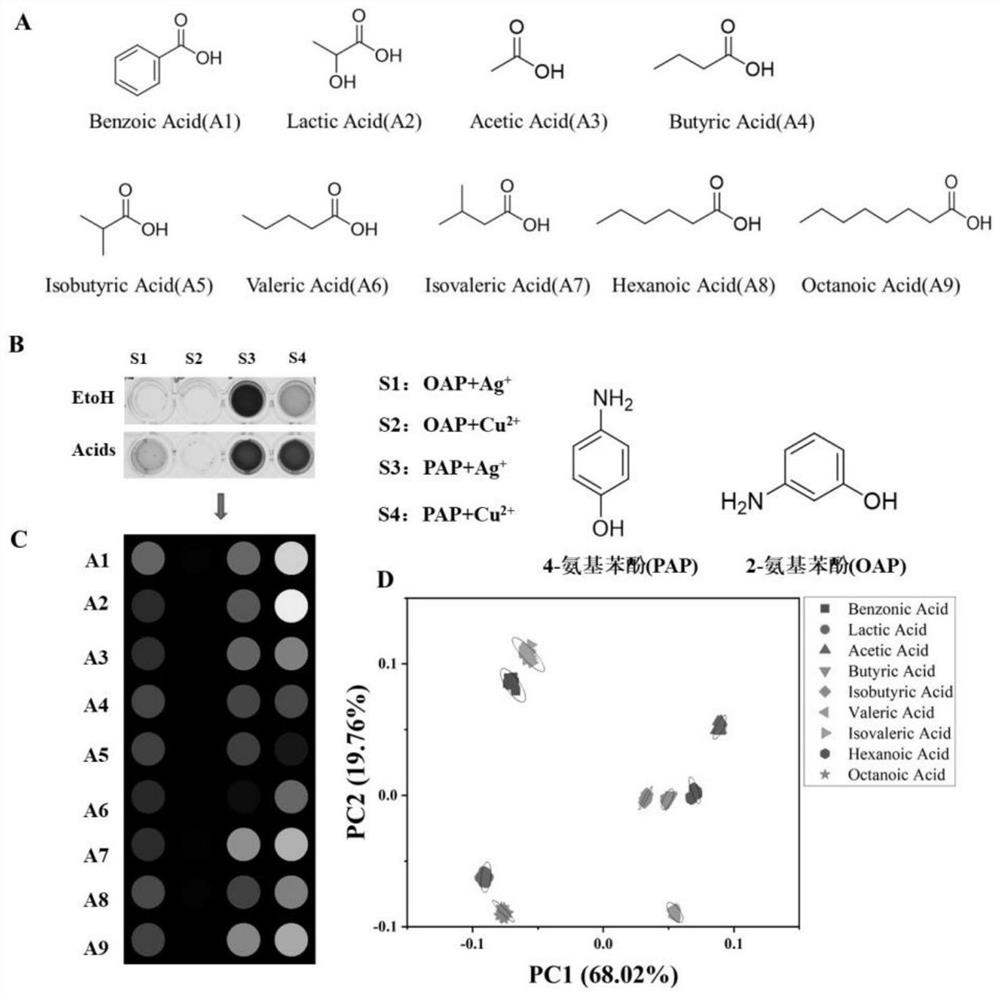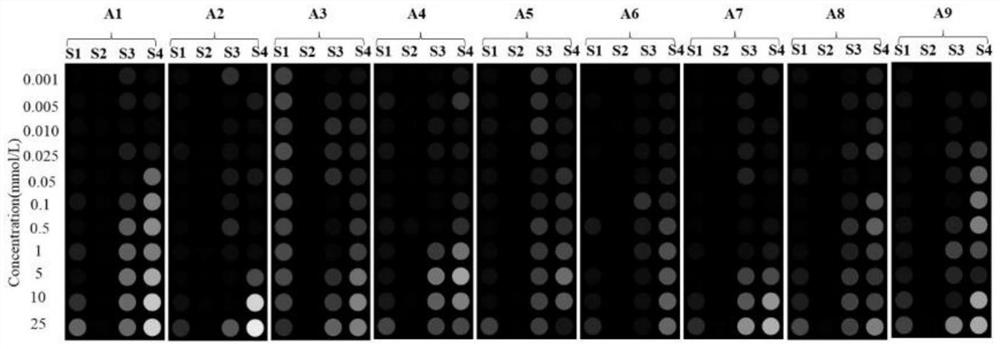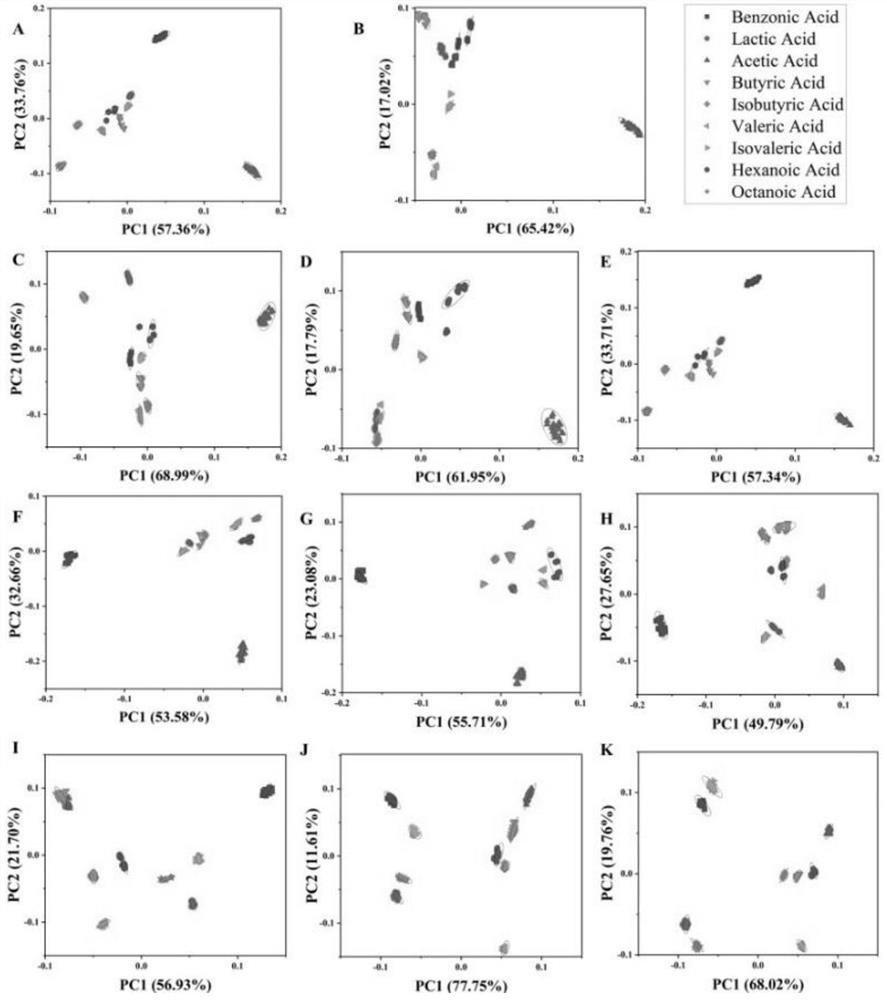Organic acid small molecule based on aminophenol-Ag < + >/Cu < 2 + >, white spirit identification method and visual sensing array
A technology of aminophenol and organic acid, which is applied in the field of organic matter identification and bionic sensors, can solve problems such as undiscovered, and achieve the effect of low cost and easy availability of raw materials
- Summary
- Abstract
- Description
- Claims
- Application Information
AI Technical Summary
Problems solved by technology
Method used
Image
Examples
Embodiment 1
[0073] The four-channel visual array sensor constructed in this example can be used to distinguish 9 kinds of organic acid compounds. It should be noted that the first sensing unit (S1) identification system A is: OAP (50mmol / L)+Ag + (25mmol / L); the second sensing unit (S2) identification system B is: OAP (50mmol / L)+Cu 2+ (25mmol / L), the third sensing unit (S3) identification system C is: PAP (50mmol / L)+Ag + (25mmol / L); the second sensing unit (S4) identification system D is: PAP (50mmol / L)+Cu 2+ (25mmol / L).
[0074] In this example, 4-aminophenol and 2-aminophenol were prepared into initial solutions of 150 mmol / L, respectively, to ensure that when 30 μL of the aforementioned solutions were added to the identification system, the 4-aminophenol, 2-aminophenol and 2-aminophenol in the system were The final concentration of phenol is 50 mmol / L; silver nitrate and copper nitrate are respectively prepared into initial solutions of 75 mmol / L to ensure that when 30 μL of the afor...
Embodiment 2
[0086] The four-channel fluorescence array sensor constructed in this example can also realize the identification of different mixed organic acid samples on the basis of identifying the pure substances of the above 8 organic acid compounds.
[0087] The operation of this example is the same except that the pure organic acid compound solutions of different concentrations in each channel are replaced with the organic acid mixed samples (final concentration) shown in Table 2.
[0088] Likewise, all data were repeated 6 times, their visual color differences were recorded, and their RGB values were used for further chemometric analysis. The discriminant results of its PCA analysis are as follows: Figure 5 shown. Using the model established by the PSO-VWLS-SVM method to try to quantify individual acids in the mixture, the results are shown in Table 3. The recoveries of hexanoic acid and butyric acid in the 25 mixtures are close to 100%, and the RMSEP range is 2.87 ×10 -7 ~0.00...
Embodiment 3
[0097] The array sensor constructed in this embodiment, on the basis of identifying pure organic acid and mixed organic acid components, can also realize the identification of different kinds of Luzhou-flavor liquor samples. Liquor is rich in organic acid flavor substances. Due to the different content and proportion of organic acids in each type of liquor, it constitutes different flavor types and types of liquor.
[0098] In order to explore the practical application of this visual array sensor, we selected 12 main Luzhou-flavor liquors from China, and the specific information is shown in Table 4.
[0099] Table 4 Specific information of 12 kinds of Luzhou-flavor liquor
[0100]
[0101] For the identification of liquor, it is only necessary to replace the organic acid compound solutions of different concentrations in Example 1 with liquor samples of the same volume (the liquor does not need to be diluted, and the original liquor sample is directly added), and the control...
PUM
 Login to View More
Login to View More Abstract
Description
Claims
Application Information
 Login to View More
Login to View More - R&D Engineer
- R&D Manager
- IP Professional
- Industry Leading Data Capabilities
- Powerful AI technology
- Patent DNA Extraction
Browse by: Latest US Patents, China's latest patents, Technical Efficacy Thesaurus, Application Domain, Technology Topic, Popular Technical Reports.
© 2024 PatSnap. All rights reserved.Legal|Privacy policy|Modern Slavery Act Transparency Statement|Sitemap|About US| Contact US: help@patsnap.com










